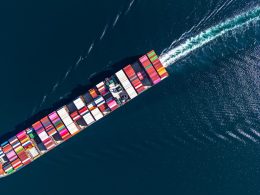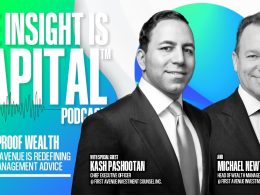by Michael Hasenstab, Ph.D., Franklin Templeton Investments
Listen to our latest “Talking Markets” podcast. A transcript follows.
Katie Klingensmith: Welcome, Michael. I’d like to get your sense of where we are right now in this ongoing period of economic uncertainty and where you see the outlook right now.
Dr. Michael Hasenstab: I think we have more challenges ahead. We’re not through this yet, however we will get through it. There is another side to this bridge and really our task is to look and identify what will the world look like when we get across this chasm. As I said, we will get across. I think there’s a lot of efforts being made to ensure that, but we also need to fully understand that the world we’re going to is probably going to be different than the world we left. And what opportunities can we find and how can we build a portfolio in that new regime? And, I think that is really the big challenge.
Certainly, on the economics, I think we are going to see significant challenges. We’ve all seen the recent March and April data, it’s been pretty unprecedented, whether levels of unemployment, collapse in activity data, collapse in trade data, that will likely continue for some time. Probably the severity will begin to abate as the lockdowns and economic activity gradually returns. But we would not expect a rapid return for both medical reasons that a rapid return doesn’t seem to be in the public health interest plan, but also the effects of what has the damage that has taken place through the shutdown will take quite some time to repair. And I think if we look at the labor market, some big stimulus efforts have been made to help provide a lifeline to people really in need. And that was necessary, but it does not replace demand. The subsidies and the assistance are not the same as returning to a job as it was two months ago. So, we see a very elevated and probably sustained for quite some period level of unemployment. The hope that all of these furloughed workers will be able to just return to existing jobs is probably a bit optimistic. I think there’s going to be some permanent damage that’s done. So, the labor market will have a feedback loop in terms of behavior on consumption, you know, people’s savings rates are likely going to be elevated for quite some time in reaction to both job uncertainty, but also the health uncertainty. I think we’ve yet to see the full extent of bankruptcies start to wash through the system. And when those start to occur, unfortunately those are going to have ramifications for the labor market and growth as well. So, I think that the economic picture will be a very gradual return, so we need to be prepared for that. I think there’s still a bit of optimism priced in the markets that this is really more of a very sharp V [shaped recovery] and we don’t share that view.
The other challenge I think that we need to be realistic about is a lot of the difficulties that the world was facing before the crisis have now just accelerated. There was a trend of deglobalization before this, that clearly is now going to move forward at a magnitude much higher than it was even before the crisis. And if we think back on the last decades the boost to economic activity was quite meaningful in terms of globalization, trade linkages, low cost supplies, lower inflationary pressures. All of those, we benefitted from and we’re going to have to unwind those in the interest of both health interests, national security interest and just general population sentiment that globalization was not the right path. And I think right or wrong, we’re going to return to a more deglobalised world and that’s going to have some pretty meaningful implications.
Katie Klingensmith: Jumping in here – it sounds like this is your ongoing concern with geopolitical struggles, which you’ve highlighted as a growing issue well before the crisis.
Michael Hasenstab: The geopolitical dynamics between countries was already fairly stressed, US-China relations going into this were probably at some of their most stressed periods really in the last 30 or 40 years and that is only likely to be further challenged in this post-coronavirus world. So I think that is a risk that people need to be aware of and a political dynamic that will probably be a reality.
Polarization trends within countries—we had a lot of fractures and divides, whether it was in the US between the red Republican states, the blue Democratic states, whether it was over income inequality issues, racial issues, urban, rural issues, all of these polarizing factors were quite elevated going into the crisis. And this crisis only escalates those even further. And we’ve seen pre-crisis that that polarization can lead to some pretty radical economic policies, some more nationalist, populist type of dynamics, which generally are not good for financial markets. And I think we need to be realistic that we’re going to expect more of those. And I’m not talking just about the US, but this applies to Europe, Latin America, Asia as well, different countries to varying degrees. So, I think we need to be prepared for, that both we will get through this, but also when we get through it will be a different world. And so, how do we map current prices to that new world? That’s really the task. It’s not current crisis to the crisis period, but what that new world will be. And I think there will be really two phases.
The first phase is we need to manage, you know, across this bridge. And I think because of the severity of some of these challenges, there will be probably further adjustments to risk and probably some downdrafts that investors need to be prepared for it. We’ve had a very fortunate last few weeks in terms of a risk rebound and stability. I think investors should use this as a period, not to be complacent, but to really think through their portfolio. We have a great window, ourselves, and clients in terms of their broader portfolio, a great window into correlations between asset classes—how portfolio construction works in severe events. And it’s not as simple as the last decade where you bought stocks and bonds and then you diversified within each of those sectors and you had a nicely uncorrelated portfolio. What we’ve seen in this last event was really those correlations collapsed into each other and there wasn’t really true diversification amongst a lot of different asset classes that people thought because of the last decade there would be. And I think this is a very important lesson to look back, look at that crisis period and say what was a diversifier? What assets can actually provide value, if we were to have another downdraft. And so from our standpoint, we’ve been doing a lot of algorithm work on clustering different types of both subsets of assets that we’re interested in, but also looking more broadly across different types of sectors and asset classes, different risk assets, safe haven assets and looking how they work together. What’s interesting as you see back say in 2000 period, if you looked at a map, it had all these nice, even little bubbles of clusters, around the page evenly distributed, separated from each other. And so that told you there was a low correlation. You could actually get diversification benefits. When you get to the GFC, those clusters to get tighter together and a little uglier. And then when you look at this last period, you have this really ugly cluster of so many different assets showing that there really was no diversification benefit.
And so, what we’re looking for is we want to position our strategy to be outside of that cluster. And there are a few other sectors that do get outside of that cluster to really help provide diversification, because if these challenges, whether economic or political between countries do continue to play out and we have another adjustment in risk, we want our strategy to be prepared outside of that cluster. And the lever that we see as value, and again, nothing is a guarantee or certain, but where our research is headed us towards were really some of these four pillars we’ve talked about in the past. First, was not really focusing on duration as a diversifier because with central banks at zero or negative interest rates in many parts of the world, there’s very limited space for that further appreciation when you’re already close or through the zero bound. I think that the benefits that long duration have had in the past are really running out of steam as we’re at that very low bound.
That being said, even though we see long term money printing inflation deficit risks, we don’t want to be in a position to be fighting the yield curve. We will have to revisit inflation dynamics. We’ll have to revisit deficit dynamics at some point, but that is probably not over the next six to 12 months.
The second is safe haven assets. And if we think about what assets could actually appreciate in a second leg down of risk markets, and again, nothing is certain or can be guaranteed, but we do feel that the safe haven assets like the Japanese yen or the Swiss franc should be good assets to help manage through that period.
Now, if we look at past periods, there sometimes is a lag, as it was in the GFC. Initially, the Japanese yen did not appreciate but after a period of a little bit more stability where you start to get through the funding crisis of dollar assets, which we initially had, but the Fed has done a great job of providing dollar liquidity. And so, I think that has eased up that market. Once you get through that initial phase, you start to see the mergers and acquisition and foreign direct investment tap turn off, as Japanese no longer sending assets abroad and you start to see some of those assets that were abroad return home. As one plays it closer to home in a period of crisis, that in the past has led to meaningful Japanese yen appreciation, which we have yet to see. So, we view that is an interesting dry powder opportunity to position for that second wave.
And the Swiss franc, in similar, is a sort of a place of stability in another round of that dynamic. I think that’s from an investment standpoint, a really interesting opportunity for two reasons. One, we think there’s dry powder that hasn’t moved yet, whereas the duration assets have already moved. And second, it has a low correlation to a lot of those other risk sectors. It’s outside of that ugly cluster and spread out, and as a result, gives you that diversifying dynamic that is very hard to find in today’s world.
The third, would be very targeted exposure in emerging markets. And I think emerging markets are going to go through an incredible stress both from the health side with the inability to really deal with the pandemic because of a lack of public health infrastructure, but also because of a synchronised global demand shock that definitely will stress countries. And so, we’re focusing on emerging markets in a couple fold. First, looking for emerging markets which we believe can manage through an acceleration of debt levels. So why do we like Indonesia, for example? Well, Indonesia’s debt to GDP is only around 30%. And so, even if it goes up 10% or 20% to 50% of debt to GDP, that is a very manageable number, especially given most of it is in domestic debt and not external debt. So, they’re not as vulnerable to an exchange rate depreciation affecting that sustainability.
So, a lot of the countries vary in their debt levels and that’s very important to pick countries we think are more sustainable. We also need to target which asset within those countries. We’ve shied away from sovereign dollar denominated sovereign credit because of liquidity dynamics, because of valuation dynamics and focused more on assets, shorter dated in the local market. Those help us maximise liquidity. Those also are more tied to central bank activity. So, when central banks cut rates in emerging markets, they can move the short end of the yield curve lower. But, it’s much more difficult to affect the long end, which can be driven by risk premium effects.
So, in general, we’ve been focusing on the front end and also, managing the exchange rate risk. In some cases, directly hedging either through options or currency forwards and in some cases, proxy hedging, pairing it against other commodity sensitive currencies that can help offset the beta moves. So, while we do see some opportunities in emerging markets, it’s through rate cuts. Because of the very dramatic economic, synchronised economic slowdown, we will expect a number of countries to continue to cut interest rates because they’re elevated, you know, Mexico just cut interest rates, you know, 50 basis points down to 6%. We would expect that to probably continue.
So, there’s a room to position for rate cuts, but it has to be at the front end of the yield curve, and it has to be currency hedged either directly or proxy hedged. Otherwise, there’s a lot of vulnerability there.
The fourth is just really maintaining the maximum liquidity, whether it’s cash, whether it’s assets owned we have avoided and still are avoiding all of the credit space. We don’t see the liquidity and the valuations that we’re comfortable with given the magnitude of what we’re about to face and the level of uncertainty about the path both economic as well as viral path. So we just don’t believe that it’s time yet for us to dip in there.
However, I would say one of the advantages of having this high liquidity is that we will be in a very good position to take risk at some point over this next period when we get another downdraft.
Katie Klingensmith: You briefly mentioned that emerging markets are certainly one of the pillars, but in a very select way. If you could provide some more insight around the opportunities that you might find eventually in emerging markets.
Dr. Michael Hasenstab: So, I think it is going to be very difficult, probably far more challenging than it was in the global financial crisis. Remember, the global financial crisis had staggered recessions. You know, US first, then Europe, and China and emerging markets really never went through one, by and large. But this time around, I think it’s going to be different. You know, we have a slowdown in all of the world. From an economic standpoint, we have, sort of, confidence panics and health issues, as well. And so, I think it’s a greater stress.
That being said, one of the advantages of some countries is really learning the lessons and lowering their external liabilities. In GFC, there were a lot of corporate external debt borrowings that quickly forced bankruptcies when currencies depreciated. Not to say we won’t see some of that pressure, but certainly on the government balance sheet, there’s been a great effort to decrease external, indebtedness and focus on issuing domestic debt.
So, a currency can depreciate. It’s an important adjustment valve, so we would expect currency depreciation. It will be a good thing long-term because as the currencies get cheap, that’s a good stimulus for growth in exports and getting the economy back as their goods become very, very inexpensive. That adjustment will occur, but it doesn’t necessarily link to a sovereign credit worthiness issue if initial debt levels were low enough.
So, we would expect debt levels are going to go higher. Growth is going to be challenged. We have to be very selective in emerging markets, but there will be many countries that do come through and viable countries that go through a difficult period as we cross this bridge. Those countries we think don’t have to go through a restructuring, can make it through the difficult exchange rates, depreciate credit spreads widening, all of the usual financial adjustments, but they will make it and that will be a tremendous opportunity—probably once in a decade, like we saw back in 2008 and 2009, but not quite there yet.
Katie Klingensmith: Moving to the developed world, how concerned are you about high deficits and debt levels?
Dr. Michael Hasenstab: Certainly, deficits at some point will become an issue. You know, the CBO in the US has come out with their new estimate looking at by the end of this year we’ll have over a hundred percent debt to GDP, you know, and continuing to go higher in the following year. And remember, they tend to be even more conservative because they just assume current state continuing, current policy continuing, not even more deficits, which is probably the likelihood. So, I think that it’s going to be a big, big challenge. In certain cases when countries run out of the ability to fundraise, money printing could be an alternative and that I think obviously long term inflationary. We have been doing a fair amount of work on this looking through history and typically while you do get inflation, it takes some time to come through. So that’s why I don’t think it’s an immediate concern, but it’s something we will have to keep an eye on eventually.
Katie Klingensmith: You touched earlier on deglobalization that we are observing right now…Can you give more perspective on this, and specifically, the role of China going forward?
Dr. Michael Hasenstab: I think certainly supply chains are going to be altered dramatically. You know, the trade frictions between the US and China were really the tip of an iceberg. It wasn’t so much per se about the trade frictions. It was about strategically, the US and China since the era of Deng Xiaoping and Richard Nixon had been looking for ways to work together, exchange ideas. There was mobility of capital, of labor, of goods and generally, a peaceful coexistence. Now that has, in the last decade and certainly in the last five years, begun to downshift. And I think within the last couple years has turned a lot more adversarial. And this crisis, with the heavy reliance upon a lot of medical goods from China by the US and by a lot of countries has probably escalated the deglobalization movement in countries outside of China, vis-a-vis China. I think there is also a growing animosity within China, about US activities. And so, that I think is a trend that is going to certainly accelerate and so, you know, we just need to be aware that there were a lot of benefits of globalization in terms of economic activity, in terms of low cost production, those are going to be reversed and there will be probably a more heavy reliance upon, you know, closer in neighboring countries for the US, as well as just domestic production of a lot of goods. So there’s going to be some big reallocations and adjustments that occur during this process.
Katie Klingensmith: You started out really emphasizing that we’re in phase one and then phase two, there may be opportunities. What in your opinion are the biggest risks right now that are perhaps still under-recognised and also where do you see opportunities that the market is not currently pricing it?
Dr. Michael Hasenstab: So I think there are opportunities in phase one and phase two. Phase one is the safe haven assets, uncorrelated potential, you know, appreciation opportunities during another downdraft, I think that is a unique opportunity. And then phase two will be buying assets that get distressed but that are still, we think, good at the end of the day. I think the biggest risk is we’ve come through something that is unprecedented in all of our lifetimes, I think there’s probably a bit of denial and I think maybe complacency now that we’ve had a bit of a bounce, but that was just sort of a surreal moment and it’s all going to pass. I think the hard work we need to do now is what is the risk or what are the dynamics going forward? And if we don’t think about how that new world will look different than the world we left, we are going to miss opportunities and we’re going to be exposed to risks.
So I think we should use this period that we just went through as a valuable insight into how assets move, how they’re correlated, how we should be building a more robust portfolio that’s not the same portfolio that has worked for a decade. It will be different, and we need to think differently. I think the biggest risk is also the biggest opportunity, it’s use this last period as a valuable insight into how to build a better portfolio.
Katie Klingensmith: Dr. Michael Hasenstab, Chief Investment Officer, Templeton Global Macro, thank you for your insights.
Host: And thank you for listening to this episode of Talking Markets with Franklin Templeton. If you’d like to hear more, visit our archive of previous episodes and subscribe on iTunes, Google Play, Spotify, or just about any other major podcast provider. And we hope you’ll join us next time, when we uncover more insights from our on the ground investment professionals.
Important Legal Information
This material reflects the analysis and opinions of the speakers as at 28 April 2020, and may differ from the opinions of portfolio managers, investment teams or platforms at Franklin Templeton. It is intended to be of general interest only and should not be construed as individual investment advice or a recommendation or solicitation to buy, sell or hold any security or to adopt any investment strategy. It does not constitute legal or tax advice.
The views expressed are those of the speakers and the comments, opinions and analyses are rendered as of the date of this podcast and may change without notice. The information provided in this material is not intended as a complete analysis of every material fact regarding any country, region, market, industry, security or strategy. Statements of fact are from sources considered reliable, but no representation or warranty is made as to their completeness or accuracy.
Data from third party sources may have been used in the preparation of this material and Franklin Templeton (“FT”) has not independently verified, validated or audited such data. FT accepts no liability whatsoever for any loss arising from use of this information and reliance upon the comments opinions and analyses in the material is at the sole discretion of the user.
Products, services and information may not be available in all jurisdictions and are offered outside the U.S. by other FT affiliates and/or their distributors as local laws and regulation permits. Please consult your own professional adviser for further information on availability of products and services in your jurisdiction.
Issued in the U.S. by Franklin Templeton Distributors, Inc., the principal distributor of Franklin Templeton’s U.S. registered products, which are available only in jurisdictions where an offer or solicitation of such products is permitted under applicable laws and regulation. Issued by Franklin Templeton outside of the US.
Please visit www.franklinresources.com to be directed to your local Franklin Templeton website.
Copyright © 2020 Franklin Templeton. All rights reserved.
What Are the Risks?
All investments involve risks, including possible loss of principal. The value of investments can go down as well as up, and investors may not get back the full amount invested. Bond prices generally move in the opposite direction of interest rates. Thus, as the prices of bonds adjust to a rise in interest rates, the share price may decline. Investments in foreign securities involve special risks including currency fluctuations, economic instability and political developments. Investments in emerging market countries involve heightened risks related to the same factors, in addition to those associated with these markets’ smaller size, lesser liquidity and lack of established legal, political, business and social frameworks to support securities markets. Such investments could experience significant price volatility in any given year.
There is no assurance that any estimate, forecast or projection will be realised.
This post was first published at the official blog of Franklin Templeton Investments.













